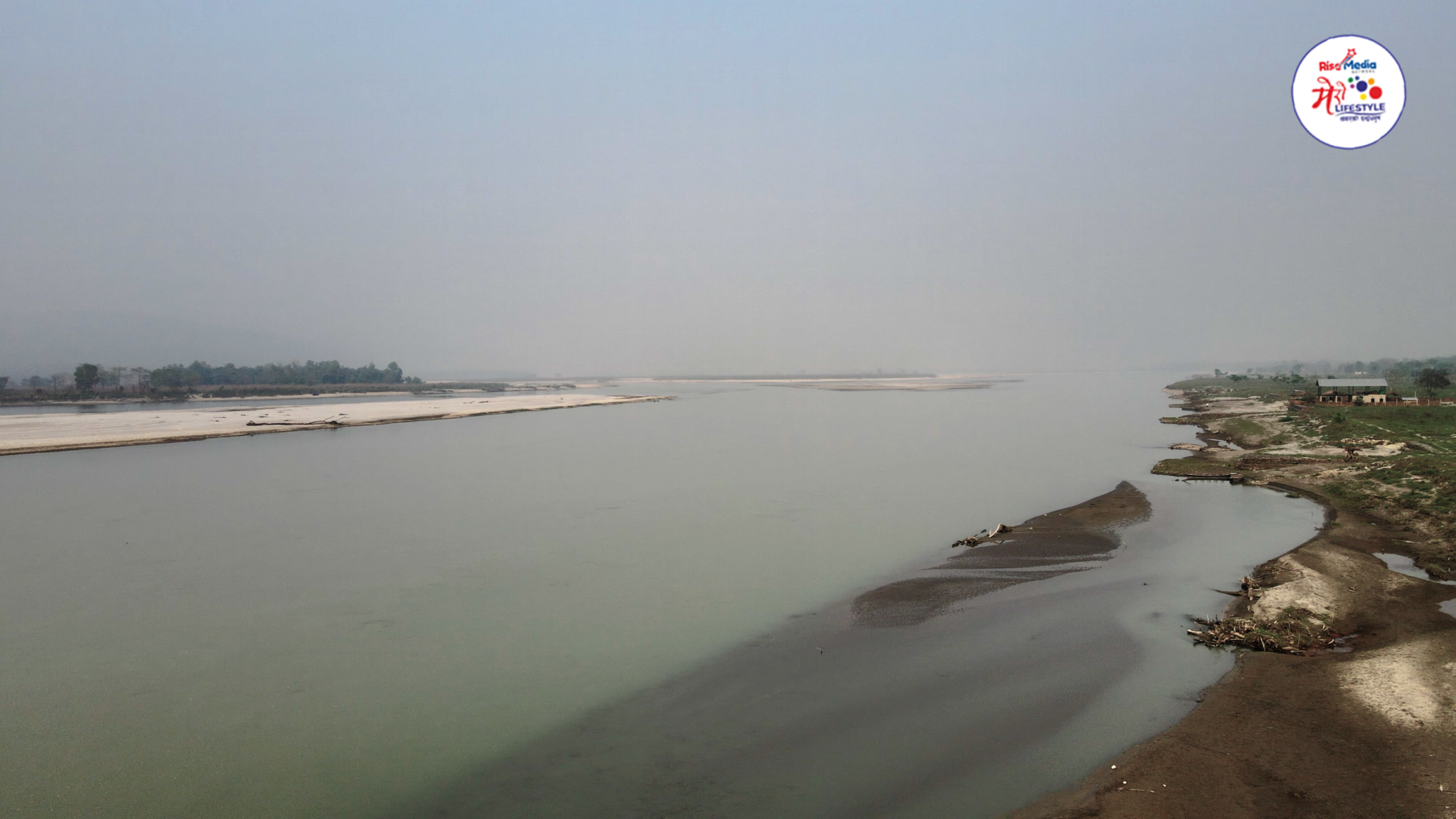Bringing Narayani River Back from the Brink

Since the emergence of the first human civilization along the banks of the Tigris and Euphrates rivers in 3000 BC in Mesopotamia (now Iraq), rivers have been deeply connected to the lives of humans and other living beings. In Nepal too, rivers have remained an integral part of the country historically and culturally. Nevertheless, the increasingly polluted waterways are mocking our civilization.
As a result of the lack of conscience of the government and citizens regarding the cleanliness of rivers, rivers in Kathmandu valley such as Bagmati, Bishnumati and Hanumante are on the verge of dying down. Many campaigns have been organized over the last few decades to revive these capital valley rivers but to no avail. Because of the mixing of toxic waste and other pollutants in the water,b habitats of aquatic animals in these rivers have been destroyed posing a huge risk to the biodiversity of the river areas.

The pollution in rivers does not only exist in Kathmandu valley; rivers outside the capital are also facing similar problems. The increase in pollution of the Narayani River is one such example. Narayani, which flows from the important Hindu religious junctions of Damodarkunda and Muktinath starts to get polluted after it flows downstream and reaches Chitwan. The main reason for this sordid state is haphazard urbanization and industrialization alongside growing use of chemical fertilizers and pesticides for cultivating agricultural crops, climate change and various types of undue human activities.

Head, Freshwater Program, WWF Nepal
The assessment will help in getting a clear picture of the impacts of the river pollution on the aquatic biodiversity and will also suggest ways for making improvements.
To save Narayani from facing the same fate as Bagmati, a river health assessment of the Narayani River is being carried out by Kathmandu University in partnership with WWF Nepal. According to Rajesh Sada, Head of Freshwater Programs at WWF Nepal, the assessment will help determine the quality of water, status of river health and the impacts on biodiversity and ecosystems in the riverscape. “The assessment was deemed necessary to examine the situation as different endangered and critically endangered aquatic and terrestrial animals, vegetation and also humans are dependent on the river,”. Mr. Sada further added, “The assessment will help in getting a clear picture of the impacts of the river pollution on the aquatic biodiversity and will also suggest ways for making improvements.”
Prof. Dr. Subodh Sharma, Registrar of Kathmandu University and a renowned water expert, who is leading the study team says that aquatic animals in some parts of the Narayani are facing existential threats due to the increasing pollution of the river. “Examining a river is like carrying out a health check-up of a person by testing his/her blood,” he said. “The river water is akin to blood for the environment and ecosystem. We examined the water of Narayani, but the river does not seem to be in a good condition.”
How is the river water examined?
There are several ways to examine river health. For a long time, experts relied on a chemical process to examine samples to determine the level of different chemicals like potassium, magnesium, calcium, nitrate, sulfate, phosphorus, and industrial wastes like lead, cadmium and copper.
We examine whether such animals and their diversity exist in the river or not. If the biodiversity is found at an elevated level, it shows the quality of water is satisfactory. On the other hand, if the biodiversity is found waning, we can conclude that the quality is degrading.

Registrar, Kathmandu University
and water expert
Nevertheless, the study being carried out under the leadership of Prof. Dr. Sharma focuses on the biodiversity aspect of the Narayani River. “Rivers are home to several creatures. Their presence is also important in the sense that they continuously monitor the changes in the river,” he said. “We examine whether such animals and their diversity exist in the river or not. If the biodiversity is found at an elevated level, it shows the quality of water is satisfactory. On the other hand, if the biodiversity is found waning, we can conclude that the quality is degrading.”

For examining Narayani, water samples have been taken from different places of the river. According to Sada of WWF Nepal, the samples have been collected from 17 different stations and in different seasons for research purposes. “Water of the river around the industrial zones has been found to be more polluted. The studies we carried out during different seasons in a year are being analyzed and the results will be published soon”.
The exploitation of river resources and mounting garbage is causing biodiversity degradation
According to Prof. Dr. Sharma, the condition of riverbanks denotes the situation of biodiversity. The proportion of stones, gravel and sand found in the river helps to sustain the biodiversity. Prof. Dr. Sharma ascertains that the haphazard extraction of the river resources is one of the main threats to the biodiversity in the Narayani River basin. “The insects found in the forests have 80 percent of their fetuses on banks of the river. Due to the haphazard extraction of the river resources, the fetuses get destroyed causing degradation of the biodiversity,” he mentioned.
Prof. Dr. Sharma says that the extinction of insects and the loss of biodiversity have a direct impact on the diversity of vegetables and fruits. “It is because insects are essential to the pollination of the fruits, vegetables and other plants. With the extinction of the insects, the fertility of plants will be hampered, hence causing degradation in the diversity of vegetables and fruits,” he said. Experts have been arguing for long that riverbanks should not be allowed to become the center of extraction of stones, gravels and sand.
Nonetheless, exploitation of the Narayani River is going on unchecked. Similarly, massive garbage dumps along the banks of the river have contributed to the ever-increasing pollution. According to Karun Dewan, Program Associate of Freshwater Programs at WWF Nepal, pollution has posed a big threat to the aquatic animals of Narayani. On one hand, the flow of water in the river is decreasing. And in the other hand, industrial and household wastes are also being directly dumped in the river via sewerages which have wreaked havoc in the habitats of aquatic animals and insects. “We’ve found animals that rely on Narayani to survive are dying due to the polluted water in the last few years,” he shared. “But it is unfortunate that the government has not paid attention to the deteriorating quality of the water.”

Associate, Freshwater Program
WWF Nepal
We are seeing the impacts on the traditional occupation of the Majhi community. The conflict between humans, aquatic creatures and other animals has already started as a result of the unchecked exploitation of the river and haphazard urban development.
Decreasing flow of water in the river and increasing pollutants on a daily basis are causing threat to the existence of animals like gharials, dolphins and different types of fishes in Narayani. “This has also put the livelihood of people of Majhi community who rely on fishing in Narayani river at big risk,” Dewan further said. This unchecked exploitation and polluted water have led to the disappearance of different types of fish in the river. “We are seeing the impacts on the traditional occupation of the Majhi community. The conflict between humans, aquatic creatures and other animals has already started as a result of the unchecked exploitation of the river and haphazard urban development,” he said.
High pollution in urban areas
The preliminary study has shown that the water around the vicinities of the city is more polluted. Water in Narayani, from Baguwan to Tribenighat, has been found to be less polluted,” he said. “But rapid urbanization in the northern areas is causing pollution in the downstream areas.” According to Dewan, waste materials emanating from disorganized ghats (places of cremation on river banks) and activities of visitors who come for jungle safari also contribute to increasing pollution in the Narayani River.
Threat to Chitwan National Park
It has been found that increasing level of pollution in the Narayani River can threaten the existence of Chitwan National Park. Animals in this park are dependent on Narayani for water. “But for how long will these poor animals succeed to survive if the pollution of the river is not stopped?” questioned Prof. Dr. Sharma.
Each year, gharials are released into Narayani River to conserve these endangered species. But Prof. Dr. Sharma expresses his dissatisfaction as no research has been undertaken to determine whether the water in the river is suitable for the reptiles to live. “There is a lack of study on how many of those released gharials have survived,” he said.
Almost all major rivers of Nepal flow from North to South. Prof. Dr. Sharma says that as most of the protected areas are located in the southern parts of the country, the animals of the protected areas have started to face an existential threat as a result of the polluted rivers. “Every year, domestic and foreign tourists visit these parks in large numbers contributing huge revenue to the government. But if the threat to the wildlife will cause extensive damage to the environment and also affect the government’s revenue,” he opined. Attracting Government’s attention, he said, “People who are at the decision-making level need to take note of this fact and act accordingly.”
It is possible to protect the rivers of Nepal
No matter how polluted our rivers get, they are usually washed out by floods occurring in the rainy season. Prof. Dr. Sharma believes that we can have clean and healthy rivers, if people become aware of the need to protect and conserve our rivers. “It is not difficult to protect and conserve rivers in Nepal like it is in many other countries where it becomes almost impossible to revive rivers that are highly polluted,” he said. “Rivers here can get a new lease of life within a year if people become aware and work towards keeping the waterways clean even after the rainy season.”
rivers are getting polluted beyond its natural repairing capability to support aquatic biodiversity which is a foreseeable concern. There is a pressing need for the federal, provincial, and local governments along with industries to work together in ensuring our rivers are protected to support the wellbeing of people and the biodiversit

Country Representative
WWF Nepal
Dr. Ghana S Gurung, Country Representative of WWF Nepal, highlights that the provincial and federal governments should focus on integrated river basin management and formulating environmentally responsible and socially just laws/rules while local governments should place emphasis on management of sewage and garbage to ensure proper management and conservation of rivers.
“Availability of clean water is essential for all creatures. However, it is unfortunate that our fresh water is becoming scarce and polluted at such an alarming rate.” He further added, “rivers are getting polluted beyond its natural repairing capability to support aquatic biodiversity which is a foreseeable concern. There is a pressing need for the federal, provincial, and local governments along with industries to work together in ensuring our rivers are protected to support the wellbeing of people and the biodiversity.”
Photo courtesy : WWF Nepal
Video Link :








